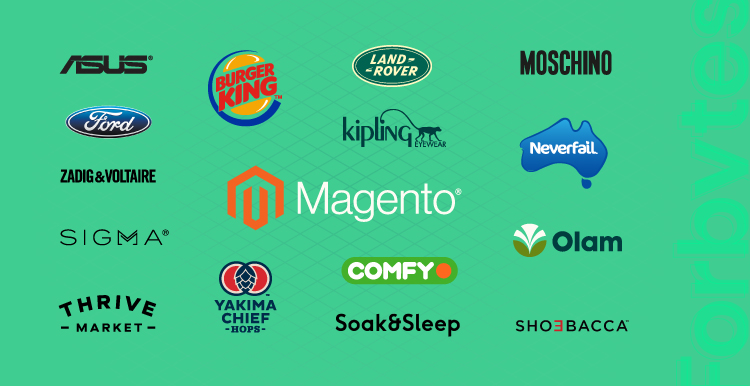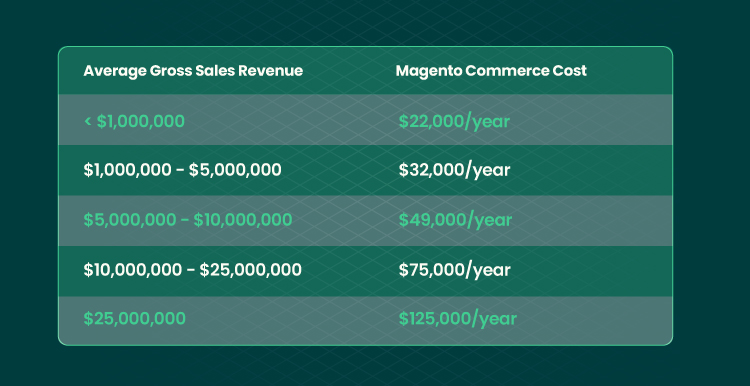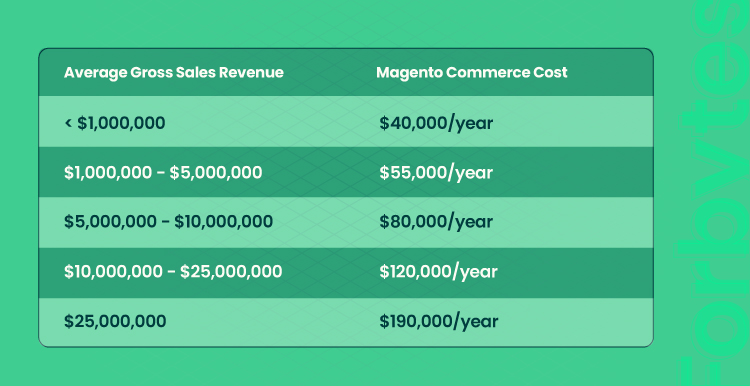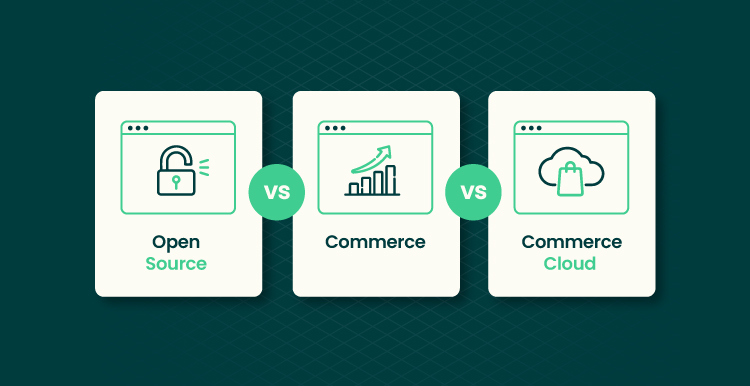In a highly competitive ecommerce environment, businesses seek solutions that can allow them to stand out. One of such solutions is Magento, an ecommerce platform used for building, customizing, and scaling online stores. Good usability and the opportunity to personalize the ecommerce experience are the features valued by users the most.
In this article, we will review 3 versions of the ecommerce Magento platform. It can help you choose the optimal option with regard to your business needs, ambitions, and budget.
Magento Technology: Quick Overview
Magento technology powers more than 250 000 active websites, which stands for more than 12% of all e-commerce stores in the world! Interestingly, if we take the top 100 000 ecommerce sites, the figures will change drastically. Magento enterprise took first place among the top ecommerce platforms used by these websites in 2021.

Since 2018, Magento has been owned by Adobe. The team regularly improves the platform and introduces new versions and updates. In November 2015, a big change happened to this technology — Magento’s team released Magento 2.0. It contained security improvements, boosted scalability, and improved code structure and code patterns. Now, Magento 1 to Magento 2 migration is a must for businesses that want to keep their websites stable, robust, and performant.
In fact, Magento 2 remains one of the leading eCommerce platforms for medium and big sellers and manufacturers. This is proved by Gartner’s Magic Quadrant for Digital Commerce. The platform is cost-optimal for developing reliable retail software. It helps you sell more on a grand scale in both B2C and B2B segments.
Many companies launch ecommerce replatforming. They move to Magento enterprise edition because of its reliability and rich functionality. Here are some of the popular vendors whose websites run on Magento software:

However, Magento Open Source, Magento Commerce, and Commerce Cloud aren’t equal. Each ecommerce solution is tailored to different demands. Let’s discuss them in the next sections.
Magento Open Source
More than 80% of Magento websites run on Magento Open Source, which is free to use. Magento 2 Open Source is previously known as Community Edition. This is a self-hosted open-source eCommerce platform. Self-hosted means that this is you who is responsible for establishing a network and server for your retail software.
As of June 2022, the latest version of Magento is Magento 2.4.3. The version includes 33 security improvements and 370 enhancements to core code. Among the security improvements, the Adobe team particularly highlights expanding reCAPTCHA coverage and adding built-in rate limiting. Source code enhancements, in turn, include the solutions to more than 290 issues posted on GitHub. This proves the technology to be community-friendly. It also enables merchants to feel safe about the future performance of their ecommerce websites.
Magento Open Source offers a basic toolkit for building a Magento website. It includes the following features:
- Integrated checkout, payment, and shipment;
- Shopping optimization for mobile devices;
- Global selling;
- Management of company accounts;
- Catalog management;
- Access to additional functionality via the app marketplace;
- Instant purchase;
- Site search.
It may seem like a lot, but the toolkit provides a bare-bones eCommerce functionality. As Magento itself masterfully puts it, ‘“Free, but at what cost?”
An Open Source solution may be great for getting acquainted with the platform or building a small online shop. However, medium and big retailers and manufacturers won’t find Open Source a sufficient option.
Not to say that it’s impossible to build a successful business with Magento Open Source. With an experienced tech team, you will have a nice shot at developing a reliable B2C online shop.
Nonetheless, the amount of effort and the number of potential risks are significantly higher than in Magento Commerce development.
It’s also important to note that, unlike Magento eCommerce, Magento Open Source does not include customer support. Also, it lacks the tools and functions to fully customize your store. To do so, you need to choose Magento Adobe Commerce. But all of this will be discussed in the next sections.
Magento Commerce
Magento 2 Commerce is previously known as Enterprise Edition. It comes with plenty of additional features on top of the Magento Open Source functionality, such as:
- Business Intelligence dashboards;
- B2B functionality;
- Advanced marketing tools;
- Content staging and preview;
- Customer loyalty tools;
- WYSIWYG page builder;
- Visual merchandising;
- Product recommendations;
- Customer segmentation.
These features present the golden standard of modern eCommerce. For example, it’s difficult to imagine a successful online shop that does not have a product recommendation engine or customer loyalty tools.
All the features are crucial. But the first three are particularly interesting and important for medium and big-sized businesses aimed at growth and efficient digital expansion. Here is what sum you are going to pay for this feature-rich solution:

The price is well-justified. This is because of the out-of-the-box features that Commerce grants and an increased potential for business growth. For example, “Norwegian retailer Get Inspired sees 30% growth YoY after migrating to Magento 2.”
Magento Commerce Cloud
Magento Cloud was previously known as Enterprise Cloud. It offers the functionality of Commerce with cloud infrastructure hosting. The solution ensures scalability and enhanced ecommerce security. It also facilitates the development and continuous deployment processes.
In addition to the functionality of Commerce, Magento Commerce Cloud offers advanced features:
- Cloud onboarding support;
- Global availability;
- Cloud availability SLA up to 99.99%;
- Fast page loading with a content delivery network (CDN);
- Performance monitoring tools;
- Web application firewall;
- Enhanced security with fastly WAF and DDoS services;
- PCI compliance;
- Easy deployment;
- Streamlined updates and testing.

Magento Commerce Cloud is the best option for large enterprises. It’s best for those that deal with high traffic, plan to grow stably, and need to process a huge volume of requests daily.
Magento Open Source vs Magento Commerce
Magento stands out as an ultimate eCommerce platform for custom retail software. It includes an extensive set of features and offers the ability to adjust everything down to the tiniest details. Magento Open Source, Commerce, and Commerce Cloud cover all the demands of retailers and manufacturers. But they also differ in terms of several aspects. Here, we will discuss them in more detail. And if you look for a comparison of Magento and other ecommerce platforms, check our Magento vs Shopify article.
Starting Your Journey
Let’s compare Magento Open Source vs Commerce at the stage of downloading and installation. Magento 2 Open Source can be downloaded and installed for free. The installation time depends on the size and complexity of your e-store. Besides, this version is self-hosted, meaning that Magento users can choose on-premises hosting. If you wish, you also can find your own hosting provider that will cover all server-side responsibilities.
As for Magento Commerce, it also provides its own hosting. If you prefer cloud hosting, then you need Magento Enterprise Cloud edition, which runs on AWS.
Managing a Store
Magento Open Source gives you a basic set of features to manage small-sized ecommerce stores. Why only small-sized? Because basic functionality works well for those stores that do not need feature diversity. Also, this edition provides ecommerce businesses with a chance to adjust their stores. They can add numerous Magento extensions and choose between several themes.
Magento Commerce provides more advanced functionality. But this comes with a cost — from $22 000 yearly for Magento e-Commerce and $40 000 yearly for Magento Commerce Cloud. If the scale of your ecommerce shop and your budget allow you to start with advanced solutions, choose Magento Commerce or Magento Cloud. Also, you always can start with an open-source edition and move to the paid version once you grow.

Ensuring Security
Magento 2 was a big update with significant security improvements. These fixes help businesses feel safe about the security of their ecommerce websites. If you are a small-sized company and want to start with a free Magento edition, you can add security to your solution by hiring an outsourcing company. An experienced Magento development team will strengthen the security of your store. They will integrate various add-ons and extensions.
Meantime, Magento Commerce offers more advanced security features such as DDoS protection or a web app firewall. Yet, it is less convenient when it comes to third-party integrations and extensions. Magento Commerce cannot be adjusted that easily and the extensions are more costly.
If you are a large-scale and recognized business, choosing Magento Commerce Cloud services will be the best option. This technology has PCI Level 1 compliance, ensures flawless security, and provides support to specific customers.
Planning the Budget
For sure, in terms of costs, Magento Open Source is the most optimal choice. It is free to download and use and the only thing you need to pay for is hosting. If your hosting is Magento-managed, all back-end responsibilities lie on your service provider. This makes it far easier to manage your online store. Also, it’s a cost-effective solution for medium businesses.
As for Magento Commerce, you will have to pay more to get more. The starting price is $22 000 per year, not including hosting costs. Magento Commerce Cloud pricing is higher and starts from $40 000 and is based on gross merchandise value. That is, the cost depends on the profit you generate on the platform. The higher the average order value, the more it will cost for you to use Magento Commerce Cloud.
Configuring Features
Magento Open Source has limited functionality when it comes to catalog management. If you need an advanced version where you can create gift cards, add AI-driven product recommendations, export custom catalogs, etc, then you need Magento Commerce. This edition is also better when it comes to B2B features. Such features include requesting quotes, adding various payment integrations, adding price tags, and so on.
One more thing worth discussing is marketing tools. Customize URLs, add metatags and descriptions for a better SEO with Magento Open Source. If you need only basic marketing tools, this is a good option for you.
Although both editions offer powerful marketing functionality, Magento Commerce provides a more detailed view of product promotion and client analytics. You can use the function of audience segmentation, Google analytics, client loyalty programs, and discounts. You can set and track advanced ecommerce metrics and much more to deliver a unique brand experience.
We need to review merchandising tools as well. If you want to organize your catalog items in a specific way on a website, Magento Commerce will help you do it. Product categories, gifts, private sales — all these functions are available in this edition. If you want to have them in Magento Open Source, you need to add third-party extensions, which are usually paid.
Business intelligence dashboards grant a heap of insightful data and statistics regarding online sales and customer behavior. Such information is essential for the proper strategic development of a company as it helps to make informed decisions and business development course corrections.
B2B functionality is essential for businesses that want to expand to a new niche. Moreover, unlike Magento Open Source, Magento Commerce offers a seamless blend of B2B and B2C functionality. You can manage both B2B and B2C online stores on one Magento instance. It’s a convenient, useful, and unique tool for an ecommerce store.
Another important benefit that Magento offers is the availability of tech support. You can submit support tickets and expect timely professional help from Magento itself. In addition, the platform provides access to quick-built express packages, which are “special design and implementation packages for businesses to go live quickly and cost-effectively.”
So What Magento Version to Choose?
It’s time to sum up our discussion. What Magento Edition should you choose? Everything depends on your plans for the future, the scale of your business, and the functions you are ready to pay for.
If you don’t want to invest in Magento as of yet or simply require the bare-bones functionality, Magento Open Source will do the job. However, if you present a medium or a big-sized retail business that wants to quickly expand its digital operations and support the latest ecommerce trends, Magento Commerce is a bang for your buck. Finally, if you’re interested in the power of the cloud on top of Commerce capabilities, you can choose the Magento Enterprise Cloud edition.
Speaking from experience, starting Magento development services is a straightforward task. If you happen to lack the last piece of the puzzle — an experienced tech team — we can help you. For more than 10 years already, we provide Magento managed services, develop software and provide ecommerce consultations for international retailers.
If you need our help — get to know a bit more about Forbytes and let’s get in touch.

Our Engineers
Can Help
Are you ready to discover all benefits of running a business in the digital era?

Our Engineers
Can Help
Are you ready to discover all benefits of running a business in the digital era?








